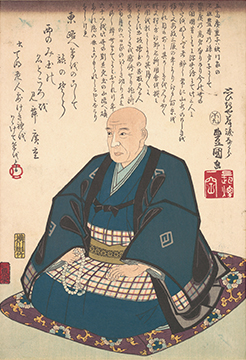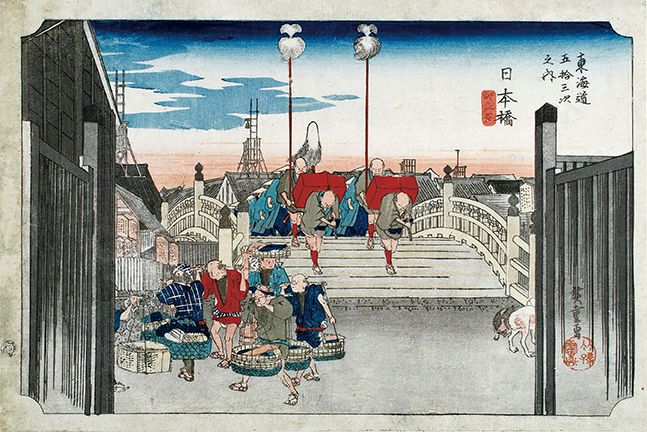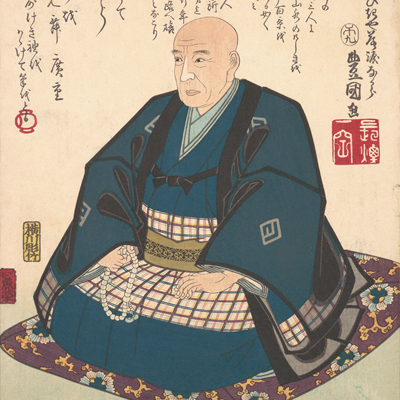

1797 – 1858
歌川広重 Hiroshige Utagawa
Childhood name: Tokutaro, later called Shigeemon, Tetsuzo, or Tokubei.
Ukiyo-e Artist who Influenced Van Gogh
“The Fifty-three Stations of the Tokaido” is an outstanding ukiyo-e artwork that is well-known globally and one of the most enduring masterpieces ever. The scenery of the Tokyo-Kyoto Highway depicted in the series was well received at the time of its publication, triggering an unprecedented travel boom in Edo, now Tokyo.
His popularity was not limited to Japan, and in the latter half of the 19th century, he became the spark that ignited Japonism (Japanese taste) in the European art world. The name “Utagawa Hiroshige” became famous throughout the world. His life and numerous activities as a painter are now known not only in the ukiyo-e world but also in the history of art worldwide.

Becoming an Heir at the Age of 13
Utagawa Hiroshige (then known as Tokutaro) was born in 1797 to a father who was an official engaged in firefighting in Edo Castle and the rest of Edo City. However, as a low-ranking official, his father’s salary was only enough to support a family of two. Despite this, Hiroshige loved to draw from an early age, just like other painters.
In 1809, when he was 13 years old, tragedy struck: his mother passed away in February, followed by his father in December. Although he had two older sisters and a younger sister, as the eldest son, he suddenly had to take over the role of father and changed his name to Shigeemon. Thus, he became the heir to the family at a very young age, becoming the mainstay of the household.
Dual Talent as a Fireman and Ukiyo-e Artist
He followed in the footsteps of his late father and supported his family as an official. However, he never turned away from painting; rather, he used his ability as a painter to help support his family. As a poor government official with a low salary, he painted as a side job to make ends meet. This dual work was typical, as many low-ranking samurai of the time had side jobs.
He began his painting career in this way but reached a turning point when he was 15 years old. He sought formal entry into the Utagawa school. At first, he applied to Utagawa Toyokuni, who was popular at the time for his paintings of bijin-ga (portrayals of beautiful women) and yakusha-e (portrayals of actors). However, Toyokuni was a successful artist with many disciples, so he refused Hiroshige (Shigeemon)’s request.
Meeting the Mentor Who Laid the Foundations for the Artist Utagawa Hiroshige
Next, through an acquaintance, he sought an introduction to Utagawa Toyohiro, a younger apprentice of Utagawa Toyokuni. Toyohiro was known as a steady painter, though less glamorous. He illustrated many books by famous authors such as Jippensha Ikku and Kyokutei Bakin.
At first, Hiroshige (Shigeemon) was turned down, but he was so persistent in his requests that Toyohiro had no choice but to allow him to join the school. This initiation led to the creation of works that would later become widely known. He was given the name Hiroshige by taking the character “Hiro” from his master, Toyohiro Utagawa, and the character “Shige” from his own name, Shigeemon.
By becoming Toyohiro’s apprentice, Hiroshige adopted Toyohiro’s style and applied it to many of his works, including his paintings of beautiful women and pictures of famous places. If he had become Toyokuni’s apprentice, he might not have been able to create the famous works he is known for today.
Life Turning Points and Farewells
In his early years, Hiroshige painted various nishiki-e (colored prints) under his mentor, but he did not paint landscapes and other famous places, which made it difficult for him to make a name for himself. Around the age of 21, he began to receive commissions for yakusha-e, and he continued his training by painting various pictures.
He received national commendation not only as a painter but also as a firefighter, which was his family’s business. He was also appointed as a firefighting instructor, and his diligent work was highly appreciated. However, he began preparing to quit his firefighter job when he married. At the age of 27, he passed the family business to an 8-year-old relative and chose to pursue painting as his primary occupation.
By the age of 33, he had a reputation as a good painter of beautiful women, although he was still low-ranked in the ukiyo-e world. Just as he was beginning his new life, his mentor, Toyohiro, passed away. Hiroshige was not able to show him great success during his lifetime. Soon after his mentor’s death, he began to publish nishiki-e. Although he still needed more individuality, as seen in Hiroshige’s later works, this change in subject matter was a significant step forward for him.
Blooming Talent
His “Toto Meisho” (Famous Places of the Eastern Capital) marked the beginning of his reputation and established his direction as an ukiyo-e artist. This work is still highly regarded today and is considered the starting point of his style. Moreover, one of his well-known styles is the use of deep blue to express the sky, water, air, and light in a unique way, later referred to as “Hiroshige Blue.” This particular color also influenced other painters.
Among his numerous paintings of landscapes and landmarks, his works are especially characterized by their depiction of everyday life in Edo rather than Edo as a tourist destination. He incorporated many techniques, including Western painting methods, into his works. Therefore, the most attractive feature of his works may have been his focus on the present moment of people’s lives in a way that was uncommon at the time, which drew many people to his paintings.
Two years after the publication of his “Toto Meisho,” Hiroshige began his masterpiece “Tokaido Gojyusantsugi” (The Fifty-three Stations of the Tokaido). Initially, the world of ukiyo-e was dominated by portraits, and landscape painting was a minor genre until the success of his “Toto Meisho” and Katsushika Hokusai’s “Thirty-six Views of Mt. Fuji.” Following this trend, the “Fifty-three Stations of the Tokaido” became popular and the most well-known title among Hiroshige’s works.
The distinctive feature of this series is that they do not depict only scenery but always include people. Each work vividly illustrates the people encountered on the roads of the journey. The characterization of the people and local specialties makes the work humorous and storytelling, leading many people to enjoy the paintings repeatedly.
Expanding His Influence Worldwide
Hiroshige’s paintings had a great influence not only in Japan but also on artists around the world, contributing to the movement known as Japonism. One of the most famous artists influenced by Hiroshige was the Dutch painter Vincent Van Gogh. One of Van Gogh’s most famous paintings, “Japonaiserie: Bridge in the Rain,” was directly inspired by Hiroshige’s work.
Utagawa Hiroshige’s numerous achievements and his impact on the ukiyo-e world continue to resonate even after his passing. Remarkably, he continues to represent Japan and influence the art world beyond his time.

.
.
.




